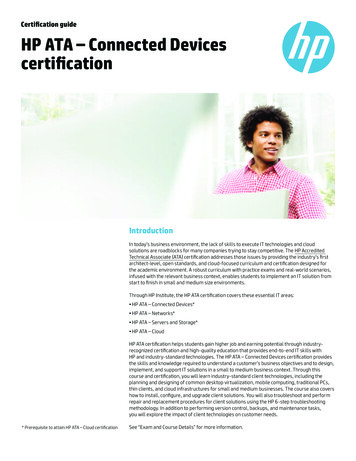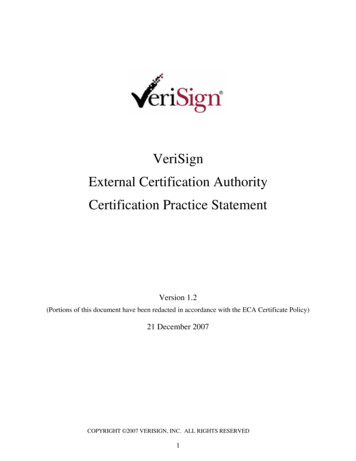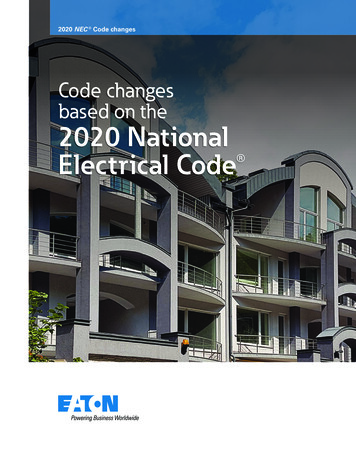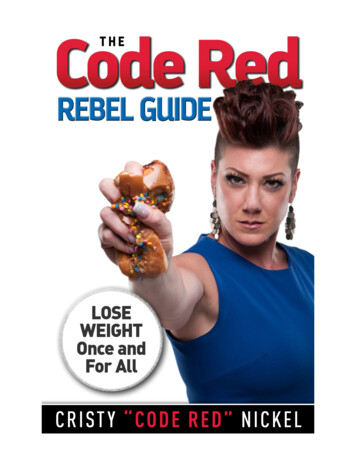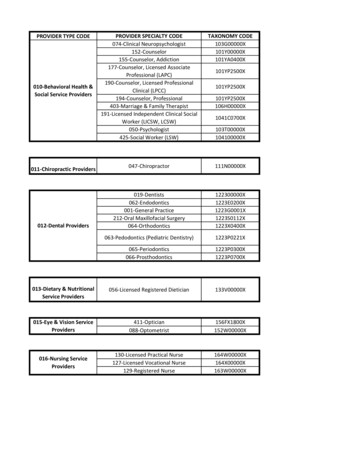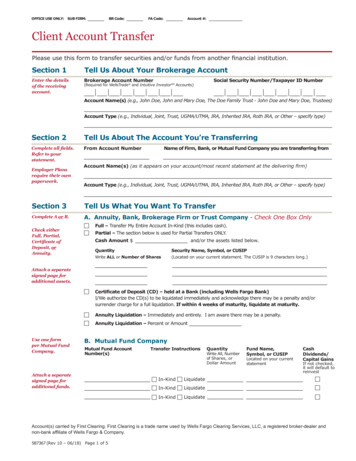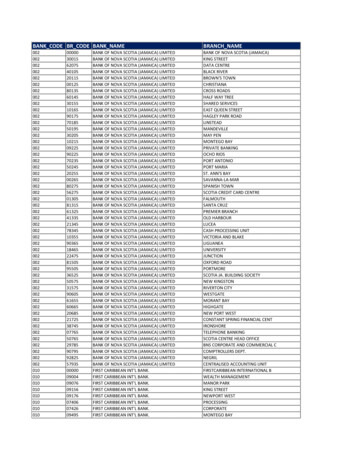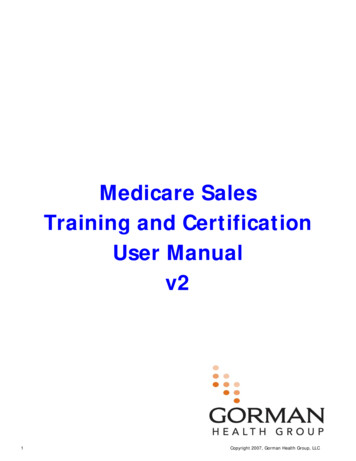
Transcription
SCS Global Services ManualCertification Manual for SQF CodeFood and Agricultural Services (SCS-FAS)2000 Powell Street, Ste. 600, Emeryville, CA 94608 USA 1.510.452.8000 main 1.510.452.8001 faxwww.SCSglobalServices.com
SQF CertificationThank you for your interest in SCS Global Services (SCS) Safe Quality Food (SQF) program. We are pleasedthat you are considering SCS as your certifier. SCS offers fast turnaround, competitive rates, attentiveservice and value for your money. We have a dedicated team of professionals and skilled auditors readyto assist you with all your SQF certification needs.The first step in pursuing certification will be to complete an SCS Application located at:http://www.scsglobalservices.com/food-safety and our SQF Info Request for Audit Preparation. Uponreceipt of your application and Info Request for Audit Preparation, we will scope and source the servicesrequested by your company and shortly thereafter provide you with our proposal. The SQF Code is basedon HACCP methods and principles, and provides a risk management system with reduced paperwork andaudit burdens.We recommend that you review the relevant Codes (SQF Food Safety Fundamentals (formerly Level 1),SQF Food Safety Code for Primary Production(formerly Level 2), SQF Food Safety Code for Manufacturing(formerly Level 2), SQF Food Safety Code for Food Retail (formerly Level 2), SQF Food Safety Code forStorage and Distribution (formerly Level 2), SQF Food Safety Code for Manufacture of Food Packaging(formerly Level 2), SQF Quality Code (formerly Level 3), and modules which contain the requirements forcertification based on the SQF Food Sector Category (FS) you select to comply with in order to obtaincertification. The Modules are found at http://www.sqfi.com/documents/ , in document SQF ProgramFood Sector Categories. For example: For SQF Producer/Grower Certification:FS-3, Growing and Production of Fresh ProduceModules 2: System elements and Module 7; GAP for farming of plant products (fruitand vegetables.FS-4, Fresh Produce and Nut Packhouse OperationsModules 2: System elements and Module 10: GMP for pre-processing of plant productsFS-5, Extensive Broad Acre Agriculture OperationsModules 2: System elements and Module 8: GAP for farming of grains and pulses For SQF Manufactures/Processors:FS-13, Bakery and Snack Food ProcessingModules 2: System elements and Module 11: GMP for processing of food productsFS-14, Fruit and Vegetable ProcessingModules 2: System elements and Module 11: GMP for processing of food productsFS-22, Processing of Cereal GrainsModules 2: System elements and Module 11: GMP for processing of food productsIn addition, SCS recommends that you review the rules for use of the SQF Quality Shield and Logo Ruleswhich can be found in the relevant SQF Code at Appendix 3 and Quality Code at Appendix 5.(http://www.sqfi.com/documents/)Version 8-0 (December 2017) SCS Global ServicesPage 1 of 8
In pursuing certification, key determinants of timely processing include submitting the SCS Application &Info Request for Audit Preparation, obtaining a working knowledge of the SQF Code, submitting yourdocuments for the Desk Audit and coordinating closely with SCS to set an on-site audit date.Our fees for SQF certification are based on our commitment to making certification services cost-effectivefor all prospective clients, both large and small. Our charges are reflective of actual work performed,within a limited sliding scale fee structure. To prevent any potential conflict of interest, SCS charges for itscertification reviews whether or not a certification is ultimately granted. This policy ensures that there isno incentive to issue certifications that are not earned.Key TermsSQFI has an extensive Program Vocabulary document that can be found at ab.pdfCertification — Certification by a Certification Body of a Supplier’s (client) SQF Systems as complying withthe SQF Code, as appropriate, following a Certification Audit, or Recertification, and Certify, Certifies andCertified shall have a corresponding meaning.Certification Audit — an Audit of a Supplier’s (Client) entire SQF System, including Desk Audit, where theProducer/Supplier of SQF Systems:a) has not been previously certified; orb) has been previously certified but requires certification as the earlier certification has beenrevoked or voluntarily discontinued by the Supplier.Certification Cycle-The annual period between certification audits.Contract manufacturer-Facilities that are contracted by the SQF certified supplier to produce, process,pack and /or store part of all of one or more products included in the supplier’s SQF product scope. Insome cases, a product may be manufactured interchangeably at the supplier’s site and at a contractedfacility. In other cases, a contract manufacturer may only be used intermittently to fulfill or supplementthe supplier’s production. Contract Manufacturers must follow the requirements outlined in the SQFCode.Corrective Action Plan (CAP) — Plan prepared by the client on how to resolve non-conformities.Desk Audit - A review of a Supplier’s (client) SQF System documentation, part of and the initial stage ofthe Certification Audit. A desk audit ensures the system documentation substantially meets therequirements of the SQF Code, as appropriate.Exempt-A term applied to elements of the SQF Code that the supplier does not wish to be included in theSQF System assessment, and has submitted a written request to the certification body to exclude, priorto commencement of any scheduled audit activity, Mandatory elements in Module 2 cannot be exempted.The certification body may confirm the reasons for exemption during the facility audit.Version 8-0 (December 2017) SCS Global ServicesPage 2 of 8
HACCP Method - Implementation of the Pre-requisite Programs and the application of HACCP Principlesin the logical sequence of the 12 steps as described in the current edition of the CODEX AlimentariusCommission Guidelines, or the current edition of the HACCP guidelines developed and managed by theNACMCF. The SQF Code and the SQF Codes use the HACCP method to control food safety and other qualityhazards in the segment of the food chain under construction.High-risk Process-A facility or segregated room or area that requires specific controls and/or a higher levelof hygienic practice to prevent food contamination.Non-Conformity - A failure to meet the requirements of the Standard. Non-conformities are divided intothree types; minor, major and critical.Re-Certification Audit - an audit of a Supplier’s (client) SQF System within 30 days of the anniversary ofthe certification.Scope of Certification – Outlines the Food Sector Categories and those Products to be covered by theCertificate of Registration.Surveillance Audit - means a six monthly Audit (or more frequently as determined by the CertificationBody (SCS)) of part of a Supplier’s SQF System where that system has previously been Certified or ReCertified and whose Certification is current. Multi-site Certification requires Surveillance Audits every sixmonths at a minimum.SQF Practitioner-Whether or not an SQF consultant is used, the SQF Code requires that every supplierhave a suitably qualified SQF Practitioner on site to oversee the development, implementation, reviewand maintenance of the SQF System, including the food safety fundamentals, food safety plans (at level2) and food quality plans (at level 3).”Multi-Sites - Multi-site program. Multi-site certification involves an entity certified to the SQF Code (i.e.manufacturer, packer, warehouse), or eligible for such certification, that has a network of primary suppliersub-sites that are eligible for certification to the SQF Code and are all involved in the same low risk activity.The central site and all sub-sites are all located in the one country and operate under the same food safetylegislation.N/A-Stands for ‘not applicable’ and may be reported during the audit by the auditor when an elementdoes not apply immediately but the facility is still responsible for the element. N/A may also be reportedto avoid double debiting, e.g. where a non-conformity has been raised against a similar, but moreappropriate element. In this case, the element will be reported as “N/A.”Unannounced Audit-A re-certification audit that is conducted once within every three certification cyclesand thirty (30) days either side the recertification audit date without prior notice to the SQF certifiedfacility.Version 8-0 (December 2017) SCS Global ServicesPage 3 of 8
SQF Code (Food Safety) – Certification Program Process DiagramApplication StageNew Applicant is provided with a SQF application.Applicant returns the completed application to SCS.SCS reviews the application and sends a Work Order with an estimated fee.New Applicant signs Work Order and returns it to SCS.SCS sends New Applicant the following:SCS Professional Services AgreementSQF Certification ManualNew Applicant returns the signed SCS Professional Services Agreement toSCS.SCS issues and Invoice for 50% of the audit fee.All documented procedures and policies provided for review for SQF deskaudit.Evaluation andReporting StageA Desk Audit is conducted (see key terms for definition). Based on the auditSCS determines the feasibility of moving forward toward Certification.Certification Audit (see key terms for definition)- Audit of Client’s whole SQF System, Desk Audit included.- SQF auditor conducts on-site inspection (announced orunannounced), which includes; reviewing documents, evidencegathering, and interviews.- SQF auditor provides the Client with a Non-Conformance SummarySheet with critical, major, and minor non-conformities identified, ifapplicable, during the closing meeting.- Client commits to a timetable to correct minor, major, and criticalCorrective Action (CARS).- SQF accredited auditor prepares the report of findings.Version 8-0 (December 2017) SCS Global ServicesPage 4 of 8
SQF Code (Food Safety) – Certification Program Process Diagram (cont.)Certification DecisionStageSCS issues certification decision and provides Client with certificationinformation and documentation. Certification status is logged on SQFIwebsite.Re-Certification AuditRe-Certification audit (see key terms for definition) confirmed (via WorkOrder) and conducted; Audit Report prepared by SQF accredited auditor.Surveillance AuditMulti-site organization or a site receiving a “C” rating shall be subject to a 6monthly surveillance audit (see key terms for definition). In addition,Surveillance audit confirmed (via Work Order) and conducted six months (ormore frequently based on findings) after certification decision has beenmade by SQF accredited auditor.Certification ProcessApplicants enter into a 3-stage certification process, the Application Stage, Evaluation and ReportingStage, and Certification Decision Stage.Application Stage: During the Application Stage, the SCS Application Form is completed and submitted. Completedform can be emailed, mailed or faxed. Upon receipt of the SCS Application Form, SCS will provide the Applicant with a Work Order andan estimated fee and the SCS Professional Services Agreement. Applicant signs and returns bothdocuments. SCS issues an invoice for 50% of the audit fee. Client must remit payment before evaluation canproceed. The SQF Application Form must be completed and returned to SCS prior to the audit.Evaluation and Reporting Stage: For Clients entering the Evaluation and Reporting Stage, a Certification Audit will be scheduled.The Certification Audit will include both a Desk Audit (Off-Site) and an On-Site Inspection,oInternal Audit: The Client must conduct an internal audit using the relevant SQF SelfAssessment Checklist.oDesk Audit (or Document Review Audit): This audit is conducted offsite. The Client mustsubmit pertinent food safety documents to SCS. Please review the SQF Standard to learnmore about the SQF desk audit and the certification process. See Part A section 2 of theVersion 8-0 (December 2017) SCS Global ServicesPage 5 of 8
relevant SQF Code. SCS shall notify Client of corrections or corrective actions, necessary.The onsite certification audit cannot begin until all corrections or corrective action formajor and minor non-conformities from the document review part of the audit have beenclosed out and approved by SCS.oOn-Site Inspection: SCS will work with the client to schedule the on-site CertificationAudit. An Audit Plan will be sent by SCS prior to the inspection after all major, and/orminor nonconformities are closed.oUnannounced Recertification Audit: Within three (3) certification cycles the certificationbody shall conduct one (1) unannounced re-certification audit of the supplier. Theunannounced audit shall occur in the supplier’s facility within the sixty (60) day recertification window (i.e., the anniversary date of the initial certification audit /- thirty(30) days). Currently certified SQF suppliers shall be required to undertake one (1)unannounced audit within the three (3) year certification cycle.i. The supplier’s certification cycle begins with the initial certification audit date.Unannounced re-certification audits shall occur once in every three (3)certification cycles.ii. Unannounced audits shall not be conducted on the initial certification audit oron a surveillance audit.iii. If a supplier changes certification bodies, the supplier’s unannounced recertification audit schedule shall not change.iv. The unannounced re-certification audit shall follow the protocol under the SQFCode, Part A, section 4.3 and 4.4.v. Multi-site suppliers are exempted from unannounced audits.vi. The date of the unannounced audit shall be determined by the certificationbody within the 60 day re-certification audit window. The unannounced audityear shall be determined between the supplier and certification body.vii. A defined blackou
Assessment Checklist. o Desk Audit (or Document Review Audit): This audit is conducted offsite. The Client must submit pertinent food safety documents to SCS. Please review the SQF Standard to learn more about the SQF desk audit and the certification process. See Part A section 2 of the Re-Certification audit (see key terms for definition) confirmed (via Work Re-Certification Audit . Multi .

